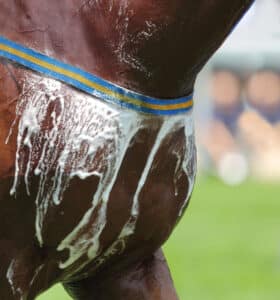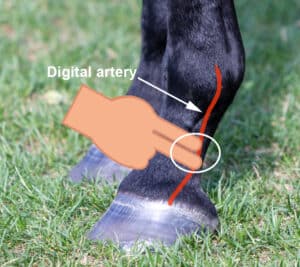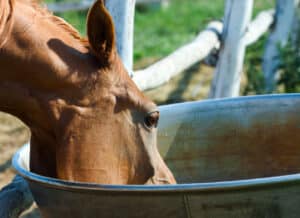In the heat of an Australian summer, keeping your horse hydrated is critical. Equine nutritionist LEISA HOFSTETTER has some advice on the subject.
As we hit the hottest months of the year, there’s no better time to think about your horse’s hydration. But if you’re thinking about hydration, you should also be thinking about electrolytes. What do electrolytes have to do with hydration? The answer is a lot.
The fact is that the two are intrinsically linked. Electrolytes are minerals with an electric charge, and they are vital to many key bodily functions. One of these functions, in humans as well as in horses, is to regulate water levels in the body. In other words, electrolytes are what your horse’s internal regulatory system uses to maintain water at the right levels. Some examples of electrolytes include sodium, chloride, potassium, magnesium, phosphorus and calcium.
A horse’s sweat is hypertonic, meaning that it carries a higher concentration of salts than their blood does. Because electrolytes must be properly balanced in order for water to be at the optimum level within the horse’s body, if both water and electrolytes are lost and not replaced, the horse will become dehydrated and their performance will be affected.

A horse’s sweat is hypertonic and carries a high concentration of salts.
To make matters worse, if a dehydrated horse is offered pure water, the remaining electrolytes in the blood are diluted even more. In response to this, their desire to drink is actually lowered, so they will often stop drinking before the lost fluid has been replaced, leaving them further dehydrated and lacking in vital electrolytes.
This means that if a horse is sweating during exercise, or due to increased ambient temperatures, or both, electrolytes must be supplemented in their feed to prevent dehydration. Use caution though, as an oversupply can have the opposite effect. Your equine nutritionist can advise you about the types and amounts of electrolytes you should add to the feed – and, in the process, potentially save you from a hefty vet bill, or worse.
During summer’s increased temperatures, your horse will obviously tend to sweat more than they would in lower temperatures, and if they’re sweating more, there’s a greater electrolyte loss, which, in turn, means their electrolyte requirements will increase. The quantity of electrolytes you will need to feed depends on the ambient temperature. For example, in ambient temperatures of 40ºC or above, daily electrolyte requirements in feed are doubled in comparison to milder temperatures. Horses in work during the hottest month of the year are especially susceptible to electrolyte loss from sweating. It is important to monitor their hydration levels at all times, but particularly when they are in work, or if you can see that they’re sweating heavily.

You can detect your horse’s digital pulse on the pastern, just below the fetlock joint.
In addition to supplementing with electrolytes, and especially if you are doing so, make sure that your horse always has access to plenty of clean, fresh water. If you suspect that they are not drinking for some reason, you can assess the amount of water they consume per day by filling a bucket with a known quantity of water (use a large measuring jug to fill the bucket to avoid a potentially inaccurate guestimate!), and then mark the water line with permanent marker. After 24 hours, you can get a rough idea of their consumption by first checking to see how far the water has dropped beneath the line, but then you need to measure the quantity of water remaining in the bucket. Subtract that from your original number to find out exactly how much has been consumed.
When using this method to check water consumption, it is important to separate the horse from their paddock mates, including other animals, so that only the horse in question is drinking from the bucket. You must also make sure the bucket cannot be tipped over or stood in.
If your horse has consumed little to no water in 24 hours, consult your vet. The amount of water horses normally drink per day is between 20 to 50 litres, but this can vary on different days and from horse to horse. However, while a difference in water intake might be quite normal, if your horse has reduced electrolytes, and hence reduced water levels, it may be dehydrated.

To check water consumption, ensure your horse is the only one drinking from the bucket and that they can’t tip it over.
If you suspect dehydration is a problem, you should call your vet immediately. Without treatment, dehydration can escalate quite quickly and may result in death. Severe dehydration will probably need to be treated with intravenous fluids, which will be administered by your vet. In some cases of mild dehydration, treating with electrolytes given orally can be successful, but don’t take the risk – call your vet and let them assess how badly the horse is dehydrated before you take matters into your own hands.
Signs of dehydration can include lethargy, stiffness, elevated heart rate, sunken eyes, dry mouth and nostrils, skin tenting, excessive or unusually limited sweating and loss of appetite. To get a better idea of whether your horse is dehydrated, you can check using several different methods, such as the skin tent test, gum test, and checking their heart rate.
The skin tent test involves pinching the horse’s skin on the neck or at the shoulder into a ‘tent’ and observing the resultant return of the skin back to its normal position. A well-hydrated horse’s skin should spring back into place in less than one second. A dehydrated horse’s skin tends to shrink back more slowly and will wrinkle up as it does so. Another sign of dehydration is a slow capillary refill time. Press gently on the gum near your horse’s upper teeth. As you press the skin will turn white, but should quickly become pink when you release the pressure. The normal refill time is two seconds, any longer could indicate dehydration.
To check your horse’s heart rate, locate their pulse. One of the easiest places to detect a horse’s digital pulse (the pulse that can be felt as blood flows through the digital artery into their hoof) is in the lower leg. Place two fingers on the pastern about two thirds back from the front of the pastern, and just below the fetlock joint. Apply a firm, even pressure. If you have found the right spot, you should feel the pulse. Once you have located it, you can count the number of beats within 60 seconds. This will be your horse’s heart rate in beats per minute. If you have a horse that is less than interested in standing still, record the number of beats you can feel in 15 seconds, then multiply the result by four. The average resting heart rate of an adult horse can vary between 25 to 45 beats per minute. A resting heart rate higher than 60 could be an indication of dehydration.
While both these tests are good indicators, they do not confirm a diagnosis of dehydration – so if you’re at all concerned or unsure, seek veterinary advice as soon as possible
Now that you understand the link between electrolytes and hydration, there’s no better time to find an equine nutritionist in your area so you can talk to them about your horse’s requirements. By monitoring their electrolyte levels, and hence their hydration levels, with the help of your equine nutritionist you can make impactful changes to your horse’s wellbeing – and that can prevent heart wrenching vet bills, or so much worse, the devastating loss of your beloved horse.
Leisa Hofstetter, BEqSc, is an Equine Nutritionist and founder of Hof Equine. Call her on 0415 120 454, visit Hof Equine or look her up on Facebook.



